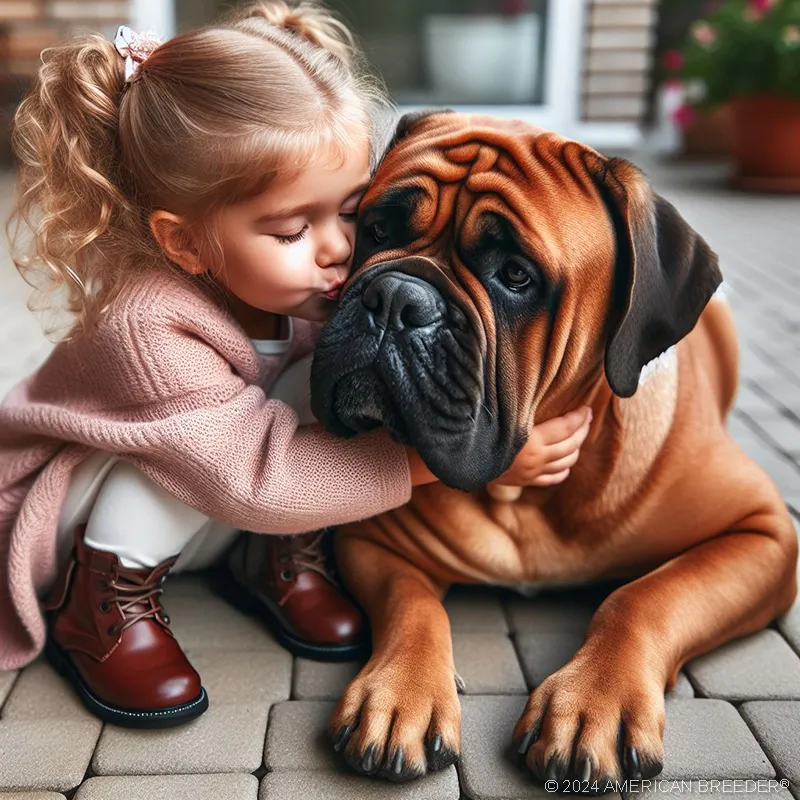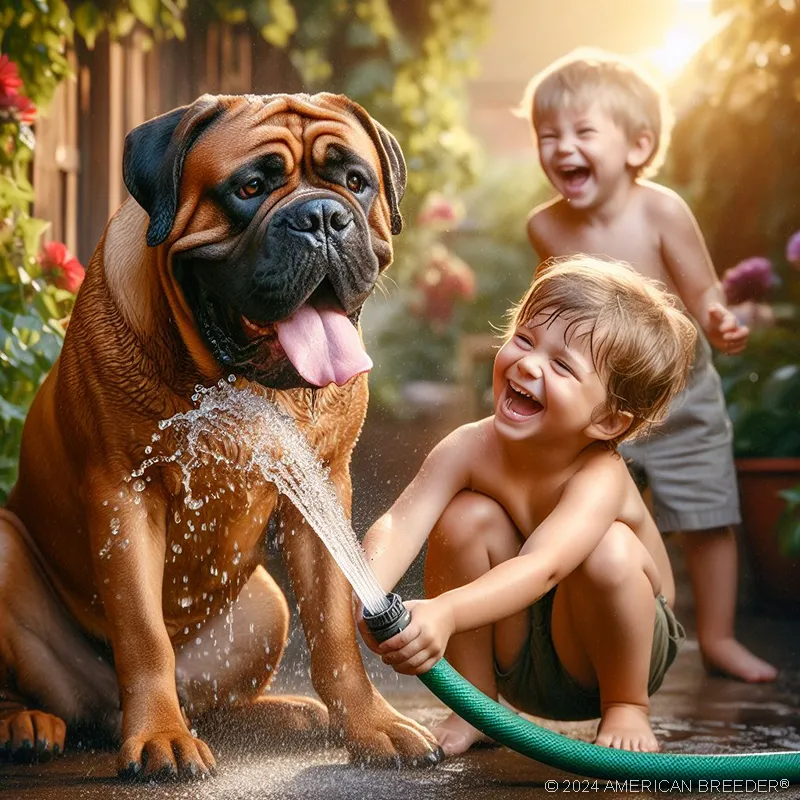Exploring the World of Bullmastiffs: Your Definitive Guide
Introduction to the Bullmastiff
 Welcome to the comprehensive guide to the Bullmastiff, a breed that embodies strength, loyalty, and gentle companionship. With its rich history, distinctive characteristics, and unique temperament, the Bullmastiff has captured the hearts of dog enthusiasts worldwide. In this guide, we'll delve into every facet of this remarkable breed, from its origins and appearance to its care, training, and more. Whether you're a seasoned Bullmastiff owner or just starting to learn about this breed, this guide aims to provide a deep understanding of what makes Bullmastiffs so special.
Welcome to the comprehensive guide to the Bullmastiff, a breed that embodies strength, loyalty, and gentle companionship. With its rich history, distinctive characteristics, and unique temperament, the Bullmastiff has captured the hearts of dog enthusiasts worldwide. In this guide, we'll delve into every facet of this remarkable breed, from its origins and appearance to its care, training, and more. Whether you're a seasoned Bullmastiff owner or just starting to learn about this breed, this guide aims to provide a deep understanding of what makes Bullmastiffs so special.
A Brief Overview of the Bullmastiff
The Bullmastiff, often referred to as the "Gentle Giant," is a formidable yet affectionate breed that originated in England. Bred by gamekeepers in the 19th century, their primary role was to protect estates from poachers. This history is evident in their powerful build, keen instincts, and unwavering loyalty. Bullmastiffs are a recognized breed by the American Kennel Club (AKC) and have made their mark in various roles, from guard dogs to beloved family pets.
Historical Significance and Purpose
The Bullmastiff's historical significance is rooted in its role as a guardian of estates. Gamekeepers sought a breed that could apprehend poachers without causing harm. By crossing the English Mastiff with the Bulldog, they created a breed with the strength to subdue intruders and the intelligence to discern between friend and foe. Bullmastiffs were often tasked with patrolling the grounds at night, using their senses and natural instincts to detect potential threats.
The breed's purpose extended beyond mere protection. Their innate loyalty and gentle disposition made them cherished companions of gamekeepers and their families. Over time, as the role of gamekeeping evolved, Bullmastiffs transitioned into roles as police and military dogs. Today, their role as loving family members remains paramount, as they continue to win hearts with their affectionate nature.
The Appearance of the Bullmastiff
 Standing with an air of dignity, the Bullmastiff is a striking breed that exudes power and grace. Their size is impressive, with males typically ranging from 25 to 27 inches in height and females slightly smaller at 24 to 26 inches. Despite their imposing stature, Bullmastiffs possess a gentle expression that reflects their friendly nature. Their well-muscled bodies are covered in a short, dense coat that comes in various shades, including fawn, red, and brindle.
Standing with an air of dignity, the Bullmastiff is a striking breed that exudes power and grace. Their size is impressive, with males typically ranging from 25 to 27 inches in height and females slightly smaller at 24 to 26 inches. Despite their imposing stature, Bullmastiffs possess a gentle expression that reflects their friendly nature. Their well-muscled bodies are covered in a short, dense coat that comes in various shades, including fawn, red, and brindle.
The coat's texture is smooth to the touch, providing a protective layer that helps them weather different climates. Their distinctive black mask adds to their unique appearance and harkens back to their Bulldog lineage. As for weight, male Bullmastiffs generally range from 110 to 130 pounds, while females are slightly lighter at 100 to 120 pounds. Their robust build, combined with their well-defined muscles and balanced proportions, makes them an imposing yet incredibly attractive breed.
Temperament and Behavior
Bullmastiffs are known for their even temperament and affectionate nature, making them excellent companions for families and individuals alike. Their loyalty runs deep, and they form strong bonds with their human families. This loyalty, combined with their natural protectiveness, makes them exceptional guard dogs. Despite their protective instincts, Bullmastiffs are not aggressive by nature; they are discerning and reserved when it comes to strangers, but they can be gentle giants when properly socialized.
Their energy levels are moderate, and they tend to have a calm demeanor indoors. However, they do require regular exercise to keep them physically and mentally stimulated. Daily walks, play sessions, and interactive games are essential to prevent boredom and maintain their overall well-being. While they are generally good with children and other pets, proper socialization and supervision are important, especially given their size.
Bullmastiffs have a deep desire to please their owners, which can make training a rewarding experience. Positive reinforcement techniques work best with this breed, as they respond well to praise and treats. They have an inherent intelligence that shines through in their problem-solving abilities and adaptability to various training tasks. Early training and consistent, gentle guidance are key to fostering their best behavior and helping them become well-rounded companions.
Health and Well-Being
 As with any breed, understanding the health considerations specific to Bullmastiffs is essential for their well-being. They are generally a robust breed, but like all dogs, they can be prone to certain health issues. One of the primary concerns is their size, which can put strain on their joints and predispose them to hip and elbow dysplasia. Regular exercise and maintaining a healthy weight can help alleviate these issues.
As with any breed, understanding the health considerations specific to Bullmastiffs is essential for their well-being. They are generally a robust breed, but like all dogs, they can be prone to certain health issues. One of the primary concerns is their size, which can put strain on their joints and predispose them to hip and elbow dysplasia. Regular exercise and maintaining a healthy weight can help alleviate these issues.
Bullmastiffs are also prone to bloat, a potentially life-threatening condition where the stomach fills with gas and twists on itself. This can be prevented by feeding them smaller, more frequent meals and avoiding vigorous exercise right after eating. Additionally, their short muzzle can lead to respiratory issues in hot weather, so it's important to provide adequate shade and avoid strenuous activities in extreme heat.
Regular vet check-ups are crucial to monitor their overall health and catch any potential issues early. Vaccinations, dental care, and preventive measures against parasites should be part of their routine care. A balanced diet that meets their nutritional needs is key to their long-term health and vitality. By staying proactive and attentive to their health, you can ensure your Bullmastiff enjoys a fulfilling and happy life by your side.
Grooming and Coat Care
Despite their size, Bullmastiffs have relatively low-maintenance grooming needs. Their short coat requires regular brushing to remove loose hairs and keep their skin healthy. This also provides an opportunity for bonding and checking for any skin issues or abnormalities. Bathing should be done as needed, typically every few months or when they get dirty.
Ears and nails should also be part of their grooming routine. Cleaning their ears regularly can prevent ear infections, and keeping their nails trimmed helps maintain their overall comfort and mobility. Dental care is especially important for Bullmastiffs, as they can be prone to dental issues. Regular teeth brushing and dental check-ups are essential to prevent tartar buildup and gum disease. While their coat sheds moderately year-round, it's a good idea to have a lint brush handy, especially during shedding seasons. Providing a healthy diet rich in essential nutrients and omega-3 fatty acids can also contribute to a shiny and healthy coat. By dedicating time to their grooming needs, you not only help them look their best but also contribute to their overall well-being.
While their coat sheds moderately year-round, it's a good idea to have a lint brush handy, especially during shedding seasons. Providing a healthy diet rich in essential nutrients and omega-3 fatty acids can also contribute to a shiny and healthy coat. By dedicating time to their grooming needs, you not only help them look their best but also contribute to their overall well-being.
Training and Socialization
Training a Bullmastiff is a rewarding journey that requires patience, consistency, and positive reinforcement. Their innate desire to please their owners makes them receptive to training, and they thrive in environments where training sessions are engaging and enjoyable. Early socialization is crucial to ensure they grow up to be well-adjusted adults.
Positive reinforcement techniques, such as treats, praise, and play, work best with Bullmastiffs. They respond well to gentle guidance and consistency. Basic obedience commands, such as sit, stay, and come, should be introduced early on to establish a foundation of good behavior. It's important to expose them to various environments, people, and animals during their critical socialization period to prevent any potential behavioral issues.
Advanced training can also be a fulfilling endeavor for both you and your Bullmastiff. Their intelligence and willingness to learn make them well-suited for more complex tasks and tricks. Consider activities such as agility, obedience trials, and even therapy work, as their gentle nature can bring comfort to those in need.
Leash training is another essential aspect of their training journey. Due to their size and strength, teaching them to walk calmly on a leash is crucial for enjoyable walks. Using positive reinforcement and patience, you can help them learn to walk beside you without pulling or lunging.
Living Arrangements and Lifestyle
 Bullmastiffs are adaptable when it comes to living arrangements, but they thrive in homes with sufficient space. While they can adapt to apartment living with proper exercise, a house with a yard provides more room for them to stretch their legs. Their size and protective nature also make them excellent watchdogs for larger properties.
Bullmastiffs are adaptable when it comes to living arrangements, but they thrive in homes with sufficient space. While they can adapt to apartment living with proper exercise, a house with a yard provides more room for them to stretch their legs. Their size and protective nature also make them excellent watchdogs for larger properties.
Their energy level is moderate, but they do need daily exercise to stay healthy and happy. A combination of walks, playtime, and mental stimulation activities is ideal to prevent boredom. Engaging their minds through interactive toys, puzzles, and training sessions can contribute to a well-rounded lifestyle.
Bullmastiffs are known for their loyalty and affection toward their families, making them excellent companions for individuals, couples, and families alike. Their calm demeanor makes them suitable for households with children, but proper socialization and supervision are key to ensure harmonious interactions.
Responsible Ownership and Care
Owning a Bullmastiff comes with a commitment to responsible care. Whether you're considering adoption or choosing a reputable breeder, it's important to ensure that the dog's health and well-being are a top priority. Puppy mills and unethical breeders should be avoided to promote responsible breeding practices.
Spaying or neutering your Bullmastiff is not only responsible but also contributes to their overall health and behavior. It can reduce the risk of certain health issues and helps manage their temperament. Regular vet visits, vaccinations, and preventive care are essential to maintaining their health and catching any issues early.
Bullmastiffs are known for their loyalty and affection toward their families, making them excellent companions for individuals, couples, and families alike. Their calm demeanor makes them suitable for households with children, but proper socialization and supervision are key to ensure harmonious interactions.
Resources and Support
 Navigating the world of Bullmastiffs can be made easier with the right resources and support. Local veterinarians, trainers, and grooming services can provide valuable guidance tailored to your dog's needs. Online communities and forums dedicated to Bullmastiffs are excellent platforms for sharing experiences, seeking advice, and learning from others who have walked the same path.
Navigating the world of Bullmastiffs can be made easier with the right resources and support. Local veterinarians, trainers, and grooming services can provide valuable guidance tailored to your dog's needs. Online communities and forums dedicated to Bullmastiffs are excellent platforms for sharing experiences, seeking advice, and learning from others who have walked the same path.
Books, websites, and reputable sources can provide in-depth knowledge about the breed's history, characteristics, and care. Reaching out to breed clubs and organizations can also connect you with experts and enthusiasts who can offer insights and recommendations.
Conclusion
In conclusion, the Bullmastiff is a breed that brings together strength, loyalty, and gentle companionship. Their history as guardians and their role as beloved family members showcase their versatility and enduring qualities. Understanding their temperament, appearance, health considerations, and training needs is key to providing them with a fulfilling and happy life.
By embracing responsible ownership, committing to their care, and enjoying the unique bond that comes with having a Bullmastiff in your life, you embark on a journey that is both rewarding and enriching. Whether they're by your side as a faithful guardian or a loving companion, Bullmastiffs have a way of leaving an indelible mark on the hearts of those fortunate enough to share their lives with them.
Frequently Asked Questions
As you delve into the world of Bullmastiffs, you might have some questions. Here are answers to a few frequently asked questions to provide you with more insight:
Q1: Are Bullmastiffs good with children? A: Yes, Bullmastiffs are generally good with children, thanks to their gentle and protective nature. However, proper socialization and supervision are crucial to ensure positive interactions between them and children.
Q2: How much exercise do Bullmastiffs need? A: Bullmastiffs require moderate exercise to stay healthy and content. Daily walks, playtime, and mental stimulation activities like puzzle toys and training sessions are recommended.
Q3: Are Bullmastiffs prone to health issues? A: Like all breeds, Bullmastiffs can have certain health predispositions. Common concerns include hip and elbow dysplasia, bloat, and eye issues. Regular vet check-ups and a healthy lifestyle can mitigate some of these risks.
Q4: Do Bullmastiffs get along with other pets? A: Bullmastiffs can get along well with other pets if properly socialized from a young age. Early introductions and positive experiences with other animals can contribute to a harmonious multi-pet household.
Q5: Are Bullmastiffs good guard dogs? A: Yes, Bullmastiffs have a natural instinct to protect their families and territory. Their imposing presence and protective nature make them excellent watchdogs, but training and socialization are necessary to ensure their guarding instincts are well-balanced.
Embarking on a Lifelong Journey
Welcoming a Bullmastiff into your life is embarking on a lifelong journey of companionship, care, and shared experiences. This majestic breed offers loyalty, love, and steadfast devotion, making them a cherished member of countless families around the world. As you continue your journey, remember that each Bullmastiff is a unique individual with their own personality and quirks. From puppyhood to adulthood, your Bullmastiff will be there to offer comfort, joy, and unwavering loyalty. The time and effort you invest in their training, socialization, and care will be repaid tenfold in the form of a loving and devoted companion.
From puppyhood to adulthood, your Bullmastiff will be there to offer comfort, joy, and unwavering loyalty. The time and effort you invest in their training, socialization, and care will be repaid tenfold in the form of a loving and devoted companion.
As you explore the chapters of this guide, you've gained a deeper understanding of the Bullmastiff's history, characteristics, care requirements, and the immense joy they can bring to your life. Armed with knowledge and a heart full of love, you're now ready to provide the best possible life for your Bullmastiff—a life filled with adventures, laughter, and cherished memories.
Closing Thoughts
This comprehensive guide to Bullmastiffs has taken you on a journey through their history, traits, care, and significance. Every chapter has revealed the multifaceted nature of this breed, from their protective instincts to their affectionate nature.
As you venture into the world of Bullmastiffs, remember that responsible ownership is a commitment that requires time, patience, and devotion. But the rewards are immeasurable—a loyal and loving companion who will stand by your side through every moment of your life.
Whether you're drawn to their regal appearance, captivated by their gentle demeanor, or intrigued by their history as guardians, the Bullmastiff is a breed that has touched the hearts of countless individuals. By following the advice in this guide and embracing the journey with an open heart, you're sure to build a deep and lasting bond with your Bullmastiff—one that will enrich both your lives for years to come.
Thank you for embarking on this enlightening journey through the world of Bullmastiffs. May your days be filled with tail wags, wet noses, and the purest form of companionship that only a Bullmastiff can provide.
Bullmastiff Dog Quick Reference Guide
 Breed Background: Origin: England | Breed Purpose: Guarding and Protecting | AKC Class: Working | Year Recognized by AKC: 1933
Breed Background: Origin: England | Breed Purpose: Guarding and Protecting | AKC Class: Working | Year Recognized by AKC: 1933
Appearance: Size: Large | Weight: 100-130 lbs | Coat Type: Short and Dense | Colors & Patterns: Brindle, Fawn | Distinctive Features: Muscular Build, Strong Head
Temperament: Energy Level: 3/5 | Loyalty: 5/5 | Friendliness to Pets: 3/5 | Friendliness to Strangers: 2/5 | Trainability: 3/5 | Playfulness: 3/5 | Frequent Barker: 2/5 | Chase Instincts: 3/5 | Sense of Smell: 4/5 | Drive to Hunt: 2/5
Health & Care: Health Issues: Hip Dysplasia, Bloat | Lifespan: 8-10 years | Grooming Difficulty: Low | Exercise Needs: Moderate
Socialization: Interaction with Children: Generally Good | Interaction with Pets: Needs Early Socialization | Interaction with Strangers: Cautious | Elderly Compatibility: Gentle | Ease of Training: Moderate
Suitable Living Arrangements: Apartment: No | House: Yes | Rural Area: Yes | Yard Size Requirements: Medium to Large Yard
Training & Obedience: Trainability: 3/5 | Intelligence: 3/5 | Obedience: 3/5 | Problem-Solving: 3/5 | Easily Stimulated: 2/5 | Focus Level: 3/5 | Easily Distracted: 2/5
Financial Planning: Typical Price Range: $1,000 - $2,500 | Initial Expenses: Puppy essentials, Training | Ongoing Annual Expenses: Food, Veterinary Care
Breeding: Reproductive Maturity: 18-24 Months | Litter Frequency: Once a year | Litter Size: 5-13 puppies | Stud Cost: Varies | Breeding Challenges: Health Screening, Whelping Assistance
Did You Enjoy this Article? Share it and Help Us Spread the Word!
If you found this article helpful, we'd appreciate it if you could share it with your friends or link to it from your website, blog, or group! You can also use the convenient social share tabs on the left side of the screen to instantly share this page to your social media feed. For more ways to support and promote the American Breeder Community, visit our Share & Promote Together page for social media posts and memes you can copy and share. Your support means the world to us!
Disclaimer: The information provided in this article is for general informational purposes only and does not constitute legal, medical, financial, or professional advice. While we strive for accuracy, we make no representations or warranties regarding the completeness, accuracy, reliability, or suitability of the information. Please consult with a professional before making decisions based on the content provided. American Breeder Inc. assumes no responsibility for any errors or omissions or for the results obtained from the use of this information.
